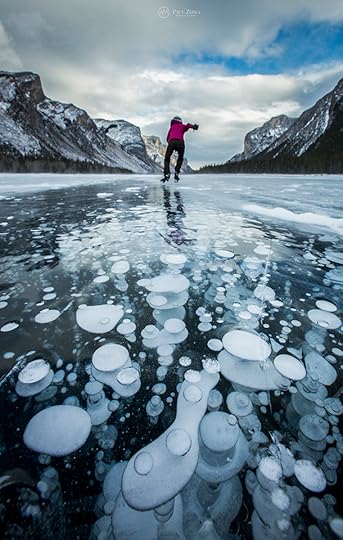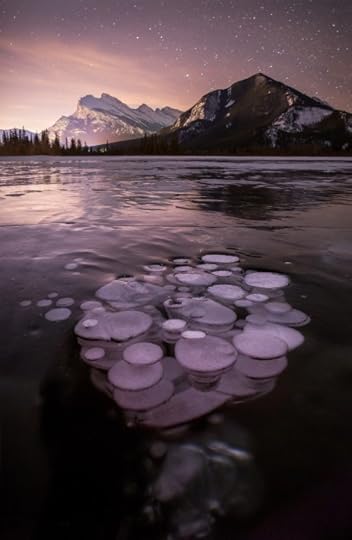Matador Network's Blog, page 2145
February 12, 2015
Drink like you're from the Outback

Photo: Aaron Booth
Get creative with your alcohol-sneaking strategies.
No one is more creative than a person from the Outback when it comes to sneaking in alcohol. An inventive example is the Esky Punch, which is simply when you empty an entire bottle of vodka into your esky (cooler) that’s full of ice. That way, if your Esky is searched for some reason, it will be assumed that the ice has just started to melt from the heat — not that it’s floating around in a litre of vodka.
Always have a tactical plan.
Longevity is something to aspire to when drinking in the Outback. Your basic goal is to outlast your mates without spending too much money. Which is why everyone knows that you always order a glass of water in a low voice that no one but the bartender can hear (the outlast part), and start the night on rum which, though costly, will get you inebriated fast. Then switch to beer, which won’t hurt the wallet as much (the cheaper part).
Know your environment and the type of drinking that it requires.
When it comes to drinking like you’re from the Outback, situational awareness is key. Going to the races and want to look classy? Drink wine or champagne. Going to the rodeo and want to appear as if you belong? Drink Bundy Rum. Going out on your boat fishing for the day and don’t want the hassle of mixing your drinks or broken glass? Cans of beer.

More like this 10 signs you learned to drink in Australia
Memorise your drinking slang.
Make sure you know the colloquial term for what you are drinking. Bush Chook, Green Cans, and Gold are all types of beer commonly drunk in the Outback. That way if someone offers you a Bush Chook, you’ll know to be appreciative and not offended.
Appropriate clothing is definitely important.
Girls, you know you should never wear high heels to the R=races. Wedges should be your go-to shoe. Then, if it starts to rain and you’ve had a few drinks too many, you’ll be thanking yourself for not having to dig your stilettos out of the mud.
Remember, more is more.
When you’re going camping for the weekend, always take more alcohol than you think you will need. Even if that means leaving out some of the food. Otherwise you’ll be caught in the dire predicament of looking for your drink, not at it. That’s rough.
Absolutely never refuse a drink someone has bought for you.
Even if you are a typical Aussie bloke that works on an Outback station, if someone buys you wine, champagne, cider, or some other drink you wouldn’t be caught dead ordering, drink it. It would be in poor taste to refuse. Plus, you’ve just saved yourself at least 10 dollars.
And above all, protect your drink.
No matter what happens, save your drink. If you are at the races in a new dress and about to trip face first into a pile of horse manure — keep that drink upright. You can always get the dress dry-cleaned. 
Monarch butterflies are in danger

Photo: jmadjedi
NORTH AMERICAN MONARCHS are an amazing keystone species — they’re the only butterfly to travel up to 3,000 miles in mass migrations from Canada and the US to Mexico for winter.
But since 1990, 970 million monarchs have vanished.
That’s a 90% fall in two decades. Only about 30 million remain, with climate change and the depletion of milkweed said to be the main factors in the butterflies’ decline.
The milkweed plant is the main food source of the monarch butterfly — it’s also their home and sole breeding ground across the United States — and it’s decreasing dramatically.

Photo: Luna sin Estrellas
Factors contributing to the destruction of milkweed include the conversion of prairies to cropland, particularly across the crucial Interstate 35 corridor from Minnesota to Texas, home to 50% of monarchs during spring and summer, and the increased use of weed killer-resistant crops that allow farmers to douse fields in milkweed-destroying herbicides.
The imperiled butterflies’ source of food, nursery, and home is being decimated, and put simply, no milkweed means no monarchs. And this isn’t just about a butterfly; it’s about environmental health as a whole.
The good news is, in an attempt to counter twenty years of destruction, the federal Fish and Wildlife Service have just announced that they’ll be putting $3.2 million into restoring monarch habitats. $2 million will go into on-the-ground conservation — milkweed seeds will be planted in refuges and other areas the Fish and Wildlife Service controls, creating 200,000 acres of habitat along the I-35.

Photo: Felix’s Endless Journey
Fish and Wildlife will also encourage other federal and state agencies to do the same on public lands, and farmers and homeowners will be part of the solution, with seeds provided to anyone willing to plant milkweed in open spaces like roadsides, parks, forests, and flower boxes. Another $1.2 million will go toward generating further funds from private organizations.
Which means the next generation might just get to see brilliant skies filled with bright orange and black butterflies after all. 
Beneath the most beautiful ice rink
On an outing to Banff National Park, Canada, photographer Paul Zizka got the chance to capture an impressive phenomenon.
While skating on Lake Minnewanka, the Vermillion Lake, and Abraham Lake, Zizka noticed methane gas bubbles trapped under the ice. The photographer had observed them before, but “some years they freeze better than others. This year they seem to have an amazing amount of detail to them”, Zizka explains to the CBC.
The low temperature in this part of Alberta in winter froze the bubbles that usually break when reaching the surface. Although they are filled with fammable methane, the bubbles are not dangerous if not lit.
For more of Zizka’s work, visit his website here. 

1
Methane bubbles underneath Lake Minnewanka, Banff National Park, Alberta, Canada

2
Skating above the bubbles of Lake Minnewanka, Banff National Park, Alberta, Canada

3
Bubbles trapped under Vermillion Lakes, Banff National Park, Alberta, Canada

4
Bubbles trapped under Vermillion Lakes, Banff National Park, Alberta, Canada

5
Bubbles trapped under Vermillion Lakes, Banff National Park, Alberta, Canada
Can you pronounce these place names?
What to do in Maine in your 20s

Photo: All Gash Brewingi
1. Get stuck in the Bar Harbor space time continuum.
When I graduated from the University of Maine, I had no idea what I was going to do after May. “Come to Bar Harbor,” everyone was saying. So I went. Within a week after graduation I was sharing a room with my friend Daniela in a men’s halfway house. Through the wall, we could hear our 58-year-old roommate Chuck Skyping with a Filipino woman he had never met. Every day at 1:45 he ate a raw hamburger on plain wonder bread. One day I went downstairs to do laundry, and there was a Chinese family living in our basement under two tarps. There was a kid from Jacksonville living in a VW bus with two flat tires in our driveway. I was working for a woman who required me to grocery shop for her before coming into the restaurant every day.
Bar Harbor is full of oddballs. Most of those oddballs have spent ten, eleven, twelve seasons trying to get out of the wacky vortex that is Mount Desert Island, but they never do. It’s where anything goes, you can spend a night tripping on LSD in Acadia National Park, wake up on Sand Beach and roll into town just in time to work the sunrise breakfast shift at Two Cat’s. You can skinny dip at Lakewood on your lunch break and start the bar shift with a shot, made for you by your boss. It took me three years to leave that place, and every May, I still consider going back.
2. Get freaky at Chickenfest in a highly planned out, top secret location.
My mom went to Chickenfest. That’s how old this tradition is. “Oh you’ve gotta go to Chicken Fest,” she told me my freshman year. And yeah mom, I did. The first time I went, I thought I was going to a barbecue in a field. This is no barbecue, although there is an exorbitant amount of chicken.
All year long, there’s an underground community of party fairies thinking about Chickenfest. They’re pouring over the gazetteer and scouting every nook and cranny of the Stud Mill Road for possible locations.
It’s always somewhere different, and for that reason, it’s never been shut down. You often have to put up with at least three rounds of decoy locations and 30 miles of dirty, muddy roads before actually making it to the party. By midnight you’ll be tripping and sipping on a PBR, dancing to Frank and the Redhots and telling that girl from your sophomore Spanish class just how much you love her cardigan. Don’t be alarmed when the helicopters fly overhead, the cops always show up just a touch too late to the party.
3. Drive up Chick Hill to howl at the full moon.
Bonus points if your headlights completely die on the way down.
4. Do something, anything, in a gravel pit.
All Maine kids know that gravel pits are gems. If those sandy walls could talk they’d speak of virginities lost on questionable abandoned mattresses, bongs smoked only to be smashed by an off-duty cop, and bonfires raging on plastic and plastic alone.
If you can master a gravel pit on a sled like you’re the next lord of Dogtown, if you can run a full circle on your CRF, if you can scale a sliding dirt wall after five consecutive rounds of flip cup — then you’re doing your 20s in Maine right.
5. Spend an August sweating your ass off on the blueberry barrens for very low pay.
Some of us raked as kids, and there’s no way we’re going back out on those fields. But if you haven’t yet spent an entire August, raking 7 days a week for $2.25 a 23-pound box — learning how to swear in Spanish and taking your morning dumps in a porta-potty that’s located in the bed of a moving truck — then you can’t call yourself real Maine.
This is a tradition that goes right back to our roots — back-breaking, hot and hard work in rural Downeast Maine. Your knees will be permanently blue and you’ll start substituting Coors Lite for water. The pay might seem low, but you can strike it big if you channel your inner machine. Plus, the end-of-season parties are pretty much unbeatable. Two words: mud wrestling.
6. Brave the strip show in Carrabassett Valley.
Or don’t. But what else are you going to do on a Friday night in Western Maine? Enjoy your early bird dinner of fish and chips, then watch as a family-friendly restaurant transforms into a full-on nightclub with poles and cages on wheels. These girls mean business too, just so you’re aware.
7. Help sort compost at the Common Ground Fair.
The Common Ground Fair is not your typical fair — you’re not going to step in vomit while in line for The Zipper and no middle-school chick is going to flash you at the Kenny Chesney concert.
This is a straight-up, old school, county fair with sweet annie flower crowns and ketchup that really tastes like salsa. There’s people on stilts banging homemade tambourines and there’s children sliding down grass hills on pieces of cardboard — screaming in utter glee as if cardboard is something other than cardboard.
If you volunteer, MOFGA will give you a free shirt and you’ll get to see all this in action for three days in a row. Plus at night, you’ll get to sing Kumbaya with volunteers from all over the world as well as Maine’s most progressive and environmentally-conscious minds.
8. Bring your own gallon of milk to a VFW dance.
If there is one tell-all sign that you are at a true Maine shindig, it’s that everyone in attendance has brought their own gallon of milk. Milk: the only appropriate follow-up to a mouthful of Allan’s coffee brandy.
9. Dive into a dumpster for the sole purpose of getting free potato chips.
Holla at me Bangor-area kids. Am I alone here? You’re young, you’re broke, and there’s absolutely nothing wrong with these chips. They’re just expired, and all crunched up, and the 24-hour security they’ve recently installed outside of the potato chip factory says that you really aren’t supposed to have them.
10. Get lectured by “Captain Joint” at Harry Brown’s farm.
The first music festival that I ever went to was at Harry Brown’s farm in Starks. I was 16, and a man named “Fred in the big red truck” left a note on my car telling me I was cute and I should take my sunglasses off for him sometime.
Nine years later, this place has changed a lot. You can dance barefoot to a knockoff Dead band, you can slurp up a locally-grown, organic hemp soup, and you can trip somewhat in peace — making knots out of grass in front of the stage while a bare-chested ex-wrestler looking man in American flag shorts lectures you about the importance of marijuana legalization, and you nod at him and think “Duh.”
11. Have a religious experience at Empire’s Clash of the Titans in Portland.
Megadeth vs Metallica. Prince vs Michael Jackson. Stone Temple Pilots vs Pearl Jam. Mars Volta vs Primus. ABBA VS ACE OF MUTHERFUCKING BASE. Go. Go right now.
12. Take the ferry out to Peaks Island so you can drunkenly pretend you’re in Jamaica.
Reggae Sundays: where a massive entourage of bros in fake dreadlock hats remind us that we are still in Maine.
Alternate idea: Make sure you’re in Bar Harbor on August 6th, Jamaican Independence Day. Spend the night sweating it out at Carmen’s to DJ Rasta Rufus, along with the huge and vibrant Jamaican community that keeps Bar Harbor thriving year after year.
13. Tube down the Presumpscot River with a 12-pack floating behind you.
Watch out though — there’s a small area of rapids and you actually have to portage over a waterfall, but this is one of the best day drinking venues you’ll come across.
14. Launch into the Atlantic Ocean off the Bar Harbor pier on a longboard.
Bonus points if you do this at lunchtime in August, during the Fisherman’s Grill takeout window’s rush hour. 
This Irish cottage may really be haunted by violent fairies

Photo: Corinne Purtill/GlobalPost
All is not well in the cottage at the edge of the Ballynageragh bog.
The simple home lies on the outskirts of this blink-and-you’ll-miss-it village in west Ireland’s County Kerry.
During the last two decades, no fewer than five inhabitants of the tiny white public-owned building died suddenly in tragic and unusual circumstances.
The unsettling events have tapped into a culture of legend and supernatural belief that continues to color life here.
One man dozed off with a lit cigarette and succumbed to smoke inhalation. Another hanged himself shortly after moving from the house. One inhabitant died in a car accident, and a fourth was stabbed to death while traveling in Wales.
Then in November 2013, neighbors found the body of Susan Dunne, 62, in one of the cottage’s bedrooms.
She had moved in 18 months earlier with her autistic teenage son, who stands accused of her murder. Patrick Dunne, 19, is being held in a Dublin mental hospital until his trial in April.
Dunne’s murder was the last straw. Villagers buttonholed Kerry County Councillor Robert Beasley during local election campaigns in May to say they wanted the county-owned house destroyed.
Although Beasley says he raised the motion at council meetings, several factors have delayed a decision about the cottage’s fate.
Among them, no action will be taken until the county has arranged with Susan Dunne’s family to remove her belongings, which remain in the house.
But for all those who want the house leveled, there are also many who argue that the deaths were just a coincidence that doesn’t justify the demolition of a perfectly good dwelling.
Ireland’s devastating financial collapse in 2008 and prolonged recession forced the local authorities to slash budgets. As a result, County Kerry has been slow to replenish its public housing stock. Waiting lists are long.
A photo posted by Corinne Purtill (@corinnepurtill) on Oct 30, 2014 at 4:03am PDT
Some would be happy to live with the cottage’s bloody legacy as long as they have a roof over their heads, locals say.
“There’s a lot of people who would love to have it,” says Paddy Quilter, proprietor of Quilter’s pub in Lixnaw. “All this bullshit about knocking it down — ah.”
Quilter says he doesn’t believe in ghosts. A clutch of locals drinking at the bar nod in agreement. But all are familiar with the host of legends, superstitions and fairies that once populated late-night tales in rural Ireland — and that still have real-world implications for many people.
“In the old days, they called it piseog,” Quilter says, a Gaelic term (pronounced pi-shawg) meaning superstition, voodoo or anything suggesting a supernatural power at hand. “There were a lot of piseogs and ghosts before electricity came in.”
It’s a word someone might use to explain an unusual or unsettling phenomenon — the mysterious deaths of five residents of a single cottage, for example.
Industrialization weakened Ireland’s belief in the fairy world but didn’t stamp it out completely, says Criostoir Mac Carthaigh, an archivist at the National Folklore Collection in Dublin.
As a result, he says, many people adopt a better-safe-than-sorry stance. Some farmers continue their forebears’ habits of not plowing certain parts of a field said to be favored by fairies, while disavowing belief in the supernatural themselves.
“Even down to today, there’s kind of a residual belief and it’s not articulated, it’s not spoken about,” Mac Carthaigh says. “’Leave well enough alone,’ is a phrase you sometimes hear people say.”
Sometimes it goes farther than that.
In 1999, the National Roads Authority was notified that a proposed bypass in western Ireland would destroy a hawthorn bush that played an important role in fairy military history. (You read that correctly.)
Irish fairies are no Disneyfied pixies. They hold grudges. Destroying the bush could result in violent fairy retribution — faulty brakes, mangled cars, death.
The government rerouted the highway and built a protective fence around the bush as an offering to the spirits.
Moo. Lixnaw, Ireland. #globalpost #tbt
A photo posted by Corinne Purtill (@corinnepurtill) on Oct 23, 2014 at 7:08am PDT
The fairies’ main lobbyist in the human world in that case was Eddie Lenihan, a grizzle-bearded folklorist in western Ireland’s County Clare.
He began his career as a “seanchaithe,” or traditional storyteller, when he was completing field research for a masters degree in linguistics and found himself more interested in the stories old folks told than the accents they told them in.
Lenihan says he’s contacted almost weekly by people who want to placate fairies on their property or suss out their feelings about upcoming construction.
His questions about the Lixnaw cottage have nothing to do with council budgets or housing demand.
“Was the house built in a place where it shouldn’t be?” he wonders. “Is there a fairy fort [a remnant of an early Christian structure] nearby?”
“It might be built on a fairy path or a funeral path, which would be a problem,” he adds. “It’d be lunacy to be on one of those. According to the old people, if you’re on a fairy path, you’ll never have peace or luck in a house like that.”
No fairy paths are evident near the cottage today. The low-slung structure, abandoned for almost a year now, stands at the end of a dirt drive blocked by a rusting gate.
Overgrown hedges encircle the property. As storm clouds closed in on a recent windy afternoon, the branches rustled with an insistent sound, like the footsteps of someone or something approaching.
The house next door is for sale. 
By Corinne Purtill, GlobalPost
This article is syndicated from GlobalPost.
5 US habits I lost in Chile

Photo: Bud Spencer
1. Guarding my food
Proper to our rustic, pioneering origins, we US citizens pride ourselves on our good ole’ individualism, our ability to pull ourselves up by our bootstraps unaided and a series of other mustachioed, cowboy hat-wearing expressions. This “I shot that buffalo, I deserve to eat it all by myself” attitude resonates profoundly within our society. In college, I earned my roommate’s eternal scorn after I helped myself to her Goldfish one night without asking permission. (To be fair, it happened to be a barrel the size of an adult panda, and I finished the box).
The Chileans I’ve know, by contrast, are significantly more communitarian. Any time any of my roommates cook, they’re sure to make enough for a regiment, and all food items in the house are up for grabs — cooked as well as uncooked. Open a fridge in most shared apartments or houses in the US and you’ll almost always find multiple milk cartons, sticks of butter, etc. While this could certainly be because all of that home’s residents are body builders in training, it’s more likely because that’s simply the way we view our food: precious goods bought with our own hard-earned cash to be consumed by the buyer and the buyer alone. Having adopted a more Chilean mindset, I no longer buy fruits or vegetables exclusively for myself. I do, however, have to check myself and not take total advantage of my roommates’ superior cooking skills, and remind myself that being able to make decent guacamole hardly brings anything to the table.
2. Referring to myself as “American”
The difficulty with this one is that we — people from the United States of America — have no proper adjective to refer to ourselves. Our historically preferred term, American, is offensive to our neighbors to the South (so far I haven’t heard a Canadian complaint, but I’m willing to bet there’s a Facebook group out there staffed by angry beaver cap-wearing Northerners), for sound reasons. While its ethnocentric and jingoistic connotations are certainly not on most of our minds, they’re nevertheless present due to our nation’s history of paternalistic and invasive foreign policy. The US’s less-than-underhanded participation in Pinochet’s installment should be enough to check any Gringo from ignoring this fact in Chile.
So it’s a pain in the ass to have to engage in verbal acrobatics and say “I’m from the US” (since “I am US” is caveman-like and incorrect), but ultimately, it’s proof of some degree of cultural sensibility (even if “US” is as imperfect a description as “American”). Plus, even though it’s a mouthful, there is a term in Spanish — estadounidense — to get you out of that sticky situation. However, since we don’t have an English equivalent — and Unitedstatesian sounds like an invading alien force — I’ll use the term “American” throughout this article for simplicity’s sake.
3. Making and sticking to concrete plans
Here’s a typical tale of Gringo woe: out and about with a group of acquaintances, one will propose you all go camping the following weekend. You, happy little foreigner, will spend the following week declining all other weekend invitations, joyfully boasting about your upcoming trip / the fact that you have friends. And then at the appointed hour, backpack at the ready, you’ll call up your friends to meet up, only to be met by utter confusion. “Camping trip? Oh yeah… we did talk about that… but no weon, can’t make it.” And there you are, alone and friendless in Santiago.
Eventually, you’ll learn not to put too much stock in theoretical plans. While we Americans are very likely to plan parties and organize weekend getaways weeks in advance, most Chileans are of the let’s-wing-it school. In my experience, it hasn’t been rare to be having a few beers with friends and then and there, decide to go camping the following day (meaning in a few hours). Luckily, the mountains are never far away.
So you’re left with two options: either bind your Chilean friends to fineable contracts, or resign yourself to the unpredictable.
4. Being hyper punctual and expecting others to be as well.
While Chileans are far from the worst when it comes to punctuality (I’m looking at you, Argentineans), their notion of time is still light years removed from Americans’. A common saying in the US — “If you’re on time, you’re already late” — is downright preposterous in Chile. In fact, if told a party begins at 10, it’s a matter of politeness to arrive at least an hour late since your hosts wouldn’t dream of anyone arriving “on time” and would undoubtedly still be getting ready themselves.
5. Considering hitchhiking a taboo.
Besides a few lone, disoriented Deadheads, no one’s hitched in the US since caftans were considered appropriate formal dress. Standing on the side of a major highway with your thumb out would probably result in a few bewildered stares and only draw sinister trucks with machetes stashed in the back. A staple of Chilean travel culture, however, hitchhiking here is quite normal and encouraged. Buses are expensive and unless you’re part of the country’s elite, planes are out of the question. Naturally, precaution ought to be exercised, especially as a woman. But the overwhelming majority of my experiences have been lovely and allowed me get a better glimpse of the country’s local cultures (not to mention put my understanding of Chilean Spanish to the test). 
February 11, 2015
What if humans disappeared?
It’s question many environmentalists have asked themselves: would the planet be better off without us, human beings?
While Nature would take over most of what humans have built, from timber houses being eaten away by termites, to steel bridges and cars turning back into iron oxyde, the damage we have done to our planet and those who live on it would never be repaired. The distribution of wildlife would never go back to what it would be without our intervention (with hippos possibly swimming in South American rivers) and our nuclear waste would (and will) persist for many, many years.
This scenario is not very hard to imagine, even the idea of alien paleontologists trying to figure out what we were doing with so much plastic seems spot on! 
Amazing feature length Parkour flim
Follow Matador on Vimeo
Follow Matador on YouTube
What happens when travel and parkour mix? You get this feature-length film — perhaps the first of its kind — from Italian director Riccardo Chemello, Reach the Horizon. Follow athletes Gian Marco Oddo, Massimiliano Takacs, and Luigi Lorenzi of Team Jestion as they jump, flip, spin, and handspring their way across Southeast Asia. 
3.5 min music video shot in 5 secs.
CALLING IT THE “SHORTEST shooting ever,” Guillaume Panariello made this three-and-a-half minute music video for Siska’s song “Unconditional Rebel” in the span of five seconds. The video was shot at a rate of 1000 frames per second from a car that was traveling at a speed of about 50 kilometers per hour, or about 31 miles per hour along an 80 meter stretch of road. The camera Panariello used was a Phantom 4k.
The music video contains 80 extras (and what appears to be a tossed cat and a few light sabers), and it is absolutely mind-blowing. The sheer logistics of getting this to work the way it does in the span of only 5 seconds must have taken significantly longer than the short shooting time suggests. Special points to whoever is able to shoot a full length movie in this way. 
Matador Network's Blog
- Matador Network's profile
- 6 followers



